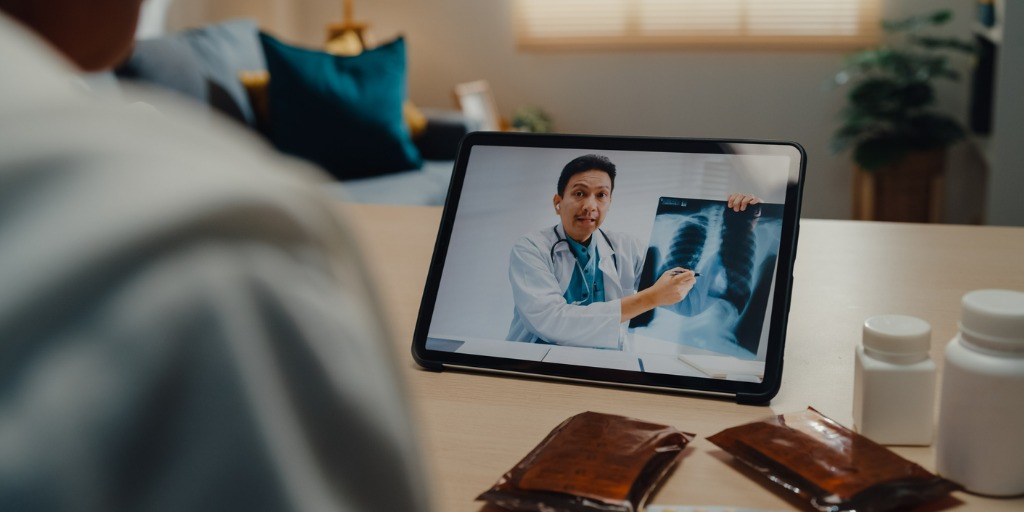Make the most of virtual health visits with these 5 tips
Virtual healthcare visits increased gradually but slowly before the Covid-19 pandemic. But then stay-at-home orders and lockdowns turned telemedicine from a potential option into a necessity.
When Medicare expanded the use of federal funds for telehealth visits—and the Department of Health and Human Services (HHS) relaxed privacy restrictions so health providers could use platforms like FaceTime, Microsoft Teams, and Zoom—the boom was official, and there's no going back. In the past couple of years, the widespread use of telehealth has highlighted its effectiveness and benefits.
But that doesn't mean there's no room for improvement. Talking to one another over a screen instead of in a clinical setting can still feel like a depersonalized experience. Fortunately, there are some easy ways to make a better connection, for both providers and patients. Consider these five for your next healthcare session:
1. Prepare in advance
Much like an in-person appointment, the time will be better utilized if both patient and provider have the same information available—such as results of lab tests or imaging—as well as goals for the conversation and patient questions. The HHS suggests online forms can be especially helpful since they can become part of a patient's medical record. These forms can include insurance information, symptoms, and medical history.
Another way to prepare: Make sure you have a quiet space where you can talk. Even if you're both wearing headphones that allow you to be heard with background noise, medical topics can be sensitive to a patient. Because of that, they should feel just as comfortable in a virtual space as they do in a physical one.
2. Maintain eye contact
While sitting in a provider's office, body language can let a patient know the provider is listening, even without eye contact. But in the small space of a screen, that's not always the case. Looking down, for example, can communicate engagement when someone is in person since they tend to be leaning in. But in a virtual visit, it can seem like the opposite is true.
That's why providers have been prompted to make eye contact more often. In one study, 92% of patients reported that the angle of a provider's eye contact was important to them, and that they felt more satisfied with an appointment in which eye contact was used more often.
3. Have a conversation
Although the Covid-19 pandemic has led to many people having more work meetings online or communicating with family members via technology, it can still feel like an artificial environment. Covering medical topics like symptoms and treatment is crucial, but much like the suggestion of making eye contact, sprinkling some small talk into the visit is helpful as well.
That helps patients feel more involved in a visit, which can lead to them asking more questions and sharing more information. One study on diabetes patients noted that many patients go into virtual visits feeling rushed, and worried they won't have an opportunity to speak fully. Slowing down the visit with a few moments of conversation can help ease those concerns.
4. Do a practice run
If either patient or provider hasn't used the specific technology before, it's important to take some time to get familiar with the telemedicine platform. As a patient, you can ask to "dial in" a few days or a few hours before the appointment to someone at the front desk, for example, just to test that you're able to make the connection successfully. If you're a provider, you can do the same by choosing an external contact, like a colleague, friend, or family member.
Even though virtual visits might cut down on travel for patients and be more convenient for providers, they're often still limited in terms of time. Making sure you know how the system works will prevent having to squander those precious minutes dealing with tech glitches.
5. Provide a secondary option
As anyone who's dealt with technology knows, even with a simple platform and a successful practice run, issues crop up. That might be a lost Internet connection, microphone problems, or a shift in your schedule that necessitates childcare in the patient's location. Whatever the case might be, make sure there's a backup plan so you can connect, like giving a patient your cell phone number or direct office number. If you're the patient, give the provider your number as part of your pre-call paperwork. That way, you can connect by phone instead.
Although strategies like having a backup plan, knowing the tech, and getting paperwork done in advance might not seem like they have a role in a stronger patient-provider connection, they ensure that there's more time for conversation and questions. Any tactic that can boost the amount of time talking—rather than dealing with technology—provides a chance to have a more productive and connected virtual visit.
For more health and wellness education from Mass General Brigham Health Plan, follow us on social @MGBHealthPlan
⬇️
